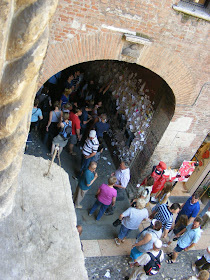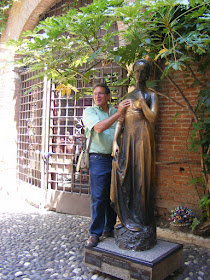This is not the first famous fictitious house I've visited. 221b Baker Street in London was good fun and made one nearly forget that Sherlock Holmes never actually existed. There weren't a huge number of other people there either; no doubt they were all in the queue for Madame Tussaud's. The other most memorable house I've visited was Anne Frank's in Amsterdam, but of course she was very real. The queue to get in wrapped around the block, but everyone was orderly and quiet throughout. You may remember our visit to the Jane Austen Centre (Heavens, was that only 6 months ago?), where they collected nearly everything associated with Jane and her time. Juliet's house reminded me a bit of this.
The outside of Juliet's house in Verona, on the other hand, is practically a mob scene. I saw a plaque in the courtyard stating their wish to get rid of the trash and graffiti, to raise the tone a bit. They have their work cut out for them. As we entered a young man was actually writing his and his girlfriend's name on the gate. She was looking on with a smitten expression. His father was taking a video. I was horrified. It gets worse. The archway just beyond the gate is plastered with paper notes, not all of which stay stuck to the wall.
Then there is the queue, not waiting to get in but waiting to be photographed with the bronze statue of Juliet. It is apparently good luck to rub her right breast and so of course it is a much shinier hue than the rest of her. I was amazed to see apparently sane, middle-aged men -- lots of them -- doing this.
I'd seen all I cared to, but Bill convinced me to return the next day and tour the house, as it is a real 15th century house if nothing else. So we did. There were no mobs in there and photographs being allowed, I enjoyed the visit immensely.
The house was sparsely furnished with pieces from that time, all dark heavy wood. The floors were large marble tiles.
Each room had a smallish fireplace and the shape of the windows looked quite Moorish to me.
There was a short hallway built onto the outside wall, half wood and half windows like a gallery.
It reminded me of the kind of sitting 'porches', sort of box windows built extending out from the upstairs floor of houses. They are very prevalent in Malta, where women used to sit to see the world, but not be seen.
In one room the ceiling tiles were lovely. In another, the ceiling fell in a series of graceful arches from the center arch.
There were any number of paintings about Romeo and Juliet. (I'm guessing there is a 'Romeo's House' somewhere but we didn't track it down.)
Also a bed that featured in Zeffirelli's movie from 1968.
I remember that I saw it (aged 13) and was swept away by the sadness and the romance, but 40 years later I could only come up with 'Olivia' so it couldn't have been that that wonderful to someone who remembers so many actors from the 1940's films.
The costumes were OK,
but mainly I liked the house. I photographed an exhibit that I thought suggested the story had its roots in fact, but upon re-reading it only says that the story line was not original to Shakespeare.
"Although immortalized in Shakespeare's tragedy, the story of Romeo and Juliet has its true literary roots in early 16th century Italy. Already around 1526, Luigi Da Porto of Vincenza wrote a novella with an exact description of the events, according to a tale heard from the archer Pellegrino of Verona. From this story came the version by Matteo Bandellow (1554) and that of Gherardo Beldier (1553) in the form of a short poem, "Adriana" by Luigi Groto (1578) represents a variant with the important detail of the nightingale taken up later by Shakespeare. In Spain, Felix Lope de Vega inserted a unique happy ending (1959), while the translations of the Italian texts by Pierre Boiteau in France and by Arthur Brooke and William Painter in England were the direct sources for Shakespeare."
What have I forgotten? Oh yeah, The Balcony. Can't leave that out.
Now I have an admission to make: I don't like Shakespeare. I remember having to study his writing in school and being completely mystified by the language. It stops me from enjoying the plays as well, though I did once muddle through "Twelfth Night" at Newcastle's Theatre Royal (great costumes). I greatly enjoyed Bill Bryson's book, Shakespeare , however, and can appreciate that the he was a genius. He also lived in the time of my favourite British monarch, Elizabeth I.
, however, and can appreciate that the he was a genius. He also lived in the time of my favourite British monarch, Elizabeth I.
I re-watched the film Shakespeare in Love the other day and quite enjoyed it, mainly because of Gwyneth Paltrow.
Verona was pretty and we enjoyed looking around, but as a World Heritage Site, I found myself slightly under-whelmed. If you've been to Verona, what did you see that we overlooked?














Is this written by the same woman who wept all the way through the Romeo and Juliet bits of "Shakespeare in Love"
ReplyDeleteHow can you say you don't like his plays
You should do a post on World Heritage sites that are worth the trip. It wouldn't be all that many.
ReplyDeleteToad - The main thing that hit me was how sparse the sites in the US and how dense in Europe - Italy, anyhow. I'd have to look at the criteria again, but it does seem to be weighted in terms of history. I guess this is why I think I overlooked something in Verona - I do love history. I would love to visit every World Heritage site, mind! Love to be so wealthy, actually.
ReplyDelete